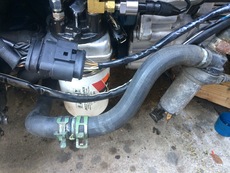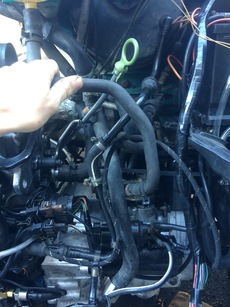With all the teed-off circuits it can be a little difficult to follow the flow of coolant in the system at first. Even still, imitating the Passat system seems to be reasonable enough, and there are plenty of leftover hoses to use.
You can generally model a coolant system similarly to an electronic system. Actual coolant flow is a function of potential to flow and ability to flow: hose diameter varies the resistance and creates a potential pressure differential to guide coolant on its path. Some of the Waßerboxer-powered Vanagons provide a good example of this: the rear heater core has a small bushing to limit flow (by creating resistance) so that the front heater core receives some flow. If that doesn't make much sense just suffice it to say that hose diameters shouldn't be changed without good reason.
How Things are Supposed to Work
Hot coolant exits the head of the TDI from both the far left (near the ABL dipstick) and the front flange. The front flange heads to the radiator, and if the thermostat is open (engine is hot) this will be the path of least resistance and cool the motor. Otherwise, the only path is out the far left flange and through the heater core(s).
You can think of the hoses connected to the head being "pressurized" (or, in electronics parlance "VCC") and the hoses connected to the three-way hose near the oil cooler as being "suction" (GND). Obviously the whole system is pressurized, but it helps to visualize flow potential.
With this in mind, the overflow reservoir outlet (bottom hose) must connect to the three-way hose, and its inlet (the very small hose) must connect to something on the head. Given that there is a nipple just for it on the front coolant flange suggests we're not totally off in left field on all this.
Connections
Left Head Outlet
 Now we'll implement the theory. The first and easiest hose to hook up is the one coming off the far-left flange on the head. Simply re-use the Passat hose that was in this location, but cut it to length after installing it on the head. The outlet is far larger than the inlet for the heater core(s), so this would be a tricky hose to recreate otherwise.
Now we'll implement the theory. The first and easiest hose to hook up is the one coming off the far-left flange on the head. Simply re-use the Passat hose that was in this location, but cut it to length after installing it on the head. The outlet is far larger than the inlet for the heater core(s), so this would be a tricky hose to recreate otherwise.
Front Return
Keep the other half of that Passat heater core line from above. The Passat uses a metal coolant pipe to wrap around the engine on its way from the heater core to the three-way hose. It's not really positioned quite right toward the back for the Eurovan, and mine was rusted pretty badly anyway. Instead of messing around with cutting it and bead-rolling the end I simply replaced it with the hose from the Eurovan that has the after-run pump attached. This is closer to how the ABL was plumbed anyway. You also get a size reducer built in.
 The top of this hose gets connected to the heater-core return line. To connect the other end you'll need a 19mm (3/4in) male-to-male barb coupler and the other half of the heater-core line that you cut above. If reliability is in your interest, you can get a metal hose joiner using Dorman part number 56430 (ask at a local auto parts store). Remove the TDI's three-way assembly from the metal coolant hose and join it to the cut hose. This then connects to the after-run pump. Note: this may need to be held out of the way somehow to avoid rubbing on the air conditioner lines.
The top of this hose gets connected to the heater-core return line. To connect the other end you'll need a 19mm (3/4in) male-to-male barb coupler and the other half of the heater-core line that you cut above. If reliability is in your interest, you can get a metal hose joiner using Dorman part number 56430 (ask at a local auto parts store). Remove the TDI's three-way assembly from the metal coolant hose and join it to the cut hose. This then connects to the after-run pump. Note: this may need to be held out of the way somehow to avoid rubbing on the air conditioner lines.
Reservoir
 The bottom of the reservoir must feed into the return line. Find a suitable hose from the Eurovan that, when connected to the bottom of the reservoir hits the hose feeding the after-run pump perpendicularly. Cut the after-run pump's hose at this point and insert a 3/4" T fitting. Without clamps, it will be a little loose for the after-run pump's hose and quite tight for the reservoir's hose, but I defy you to locate a more appropriately-sized T fitting. The larger is probably closer to 7/8" and the reservoir hose is 5/8. Lubricate the smaller hose and it can be pressed on fairly easily. (Note: consider Murray part number 84749).
The bottom of the reservoir must feed into the return line. Find a suitable hose from the Eurovan that, when connected to the bottom of the reservoir hits the hose feeding the after-run pump perpendicularly. Cut the after-run pump's hose at this point and insert a 3/4" T fitting. Without clamps, it will be a little loose for the after-run pump's hose and quite tight for the reservoir's hose, but I defy you to locate a more appropriately-sized T fitting. The larger is probably closer to 7/8" and the reservoir hose is 5/8. Lubricate the smaller hose and it can be pressed on fairly easily. (Note: consider Murray part number 84749).
Reservoir Top
Retain the stock Eurovan reservoir. The Passat one won't mount up anyway. The small hose from the reservoir to the radiator can be retained as it was. The other will need to be adapted to fit to the small hose coming from the front coolant flange.
Front Connections
This is on the docket for the next few days, but I suspect the Eurovan radiator hoses will be unusable due to their moulded-in tees. If the Passat hoses will reach and fit they will be acceptable. The flange on the bottom of the motor is the return from the lower radiator port (where cooler coolant should be). The front flange on the head is the outlet for hot coolant and connects to the top radiator port.
Considerations for Camping
Because the after-run pump is connected to the heater core it will be able to draw engine heat into the cabin even after the engine is turned off. If one was to create a way of running an interior blower fan and cycling this pump, one would have interior heat for a few hours. Coupled with some insulation inside this might be enough to get through a night comfortably after driving.
For that matter, the engine does not need to be the sole heat source. If one were to insert a heat exchanger inline with the (rear) heater core, they could plausibly heat the cabin indefinitely. Couple this with a thermostat and cold-weather camping would be very easy. Stay tuned for more on this. ![]()